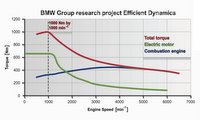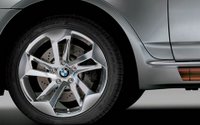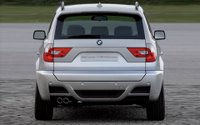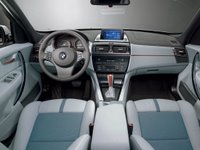SPY ----> BMW X3 EfficientDynamics Super capasitors Hybrid SUV

BMW is working on a gasoline-electric hybrid, but it's a different sort of hybrid. "Ours is lighter, faster and more efficient," says Professor Freymann. Super capacitors, power boosted by regenerative braking, replace batteries. "[The super capacitors] are lighter and store less power, but unlike batteries we can use all their power — all 100 percent." So they give a quick, high-power, short-term "fix" to a small electric motor (mated to a conventional gasoline engine), used only for standing-start acceleration. "An electric engine has a lot of torque at low revs — that is its main benefit — so it's ideal for fast initial acceleration. At higher revs, once you've begun to accelerate, nothing can beat an internal combustion engine. Our hybrid approach combines the best characteristics of both engines."
Let's have a looks on this new concepts SUV from BMW.
Model concept & Specifications:
Concept Car SUV
Length x Width x Height: 4565 x 1853 x 1674 mm
Wheel base: 2795 mm
Gross Weight: ??
Mass-Pro: Not announced.
Drivetrain Technology & Performance Highlights:
- Concept Approach: Hybrid concept BMW-style must retain typical BMW features like dynamic performance combined with optimum use of Fuel.
- Engine: 3.0L 6-Cyclinder In-line gasoline engine with Jet-guided direct injection.
- Active Transmission: Accommodating both Electric motor and Electronic control unit.
- Electric Motor: 30KW (But can be briefly boosted to 60KW) - Operating voltage 100-200V - Torque 400Nm.
- Energy supply by high performance capacitors - referred to as "SUPER CAPs" positioned behind side sills. (See photo at side view - Copper color components)
- Ancillaries such as steering servo pump, brake servo and Air conditioning compressor driven by their own Electric motors.
- Transmission: 6-Speed A/T.
- Performance: 0-100Km/h in 6.7s
- Top Speed: 235Km/h
- Fuel consumption: Reduced by Approx. 20% in European driving Cycle.




KEY ELEMENTS OF CONCEPT:
(1) Active Transmission:
No additional space required, both electric motor and electronic control unit are accommodated inside transmission housing. Electric motor is able to use the usual transmission ratios available – it can perform a whole range of different drive functions with different torque and power requirements.
The electric motor assumes the space and function of both a torque converter and a lock-up clutch. It is supplemented in its operation by 2 oil bath clutch systems: the 1st set of clutch plates connects combustion engine with electric motor, the 2nd links the electric motor with the transmission. It is easy to replace a conventional BMW automatic transmission from package-point of view.
(2) “Super Caps” Capacitors instead of conventional battery:
Energy supply not through conventional battery but by high-performance capacitors, the copper-red double-layer “Super Caps”: measuring approx. 50mm in diameter – generating overall capacity of 190kW. Able to take up a very high level of electrical energy within fractions of seconds almost without losses.
Specific power density of 15kW per kg – compared to about 1.3kW/kg of a nickel/metal hydride battery. In usual driving mode the Super Cap is offering a power density of more than 5kW/kg – compared to not even 0.5kW/kg provided by a battery. Given the same weight, voltage and power supply, a double-layer capacitor offers efficiency level of 98% versus 84% provided by NiMH battery.
The point of installation – transparent behind the side sills – ensures good results in car’s lateral and vertical dynamics as well as available space. Overall, 80 caps are installed. According to BMW employee at Motor Show, caps can store energy for 2 weeks duration.
OPERATION:
Typical basic hybrid approach – car setting off under electric power (2nd clutch) – then 1st clutch will engage and combustion engine will fire (electric motor used as starter for petrol engine).
At braking combustion engine is switched off, when gas pedal is pressed again, engine starts automatically.
At quick acceleration from standstill, 2 drive systems start together and develop combined torque of 600Nm at engine speeds below 1,500rpm (electric motor deactivated automatically at approx. 3,000rpm).
Electric motor serves also as “booster” in each of the 6 automatic transmission gears – able to cut in when combustion engine is running at low speeds (additional power required mostly for only 3 seconds).
Control strategy is laid out never to deliver more electrical energy than actually needed.




0 Comments:
Post a Comment
<< Home